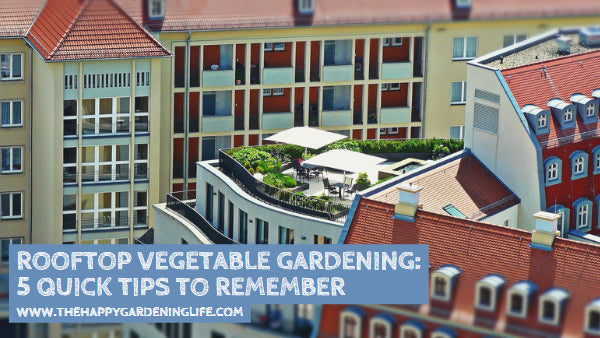
Rooftop Vegetable Gardening: 5 Quick Tips to Remember
Share
 Rooftop vegetable gardens have gained more popularity in these modern times, and it’s easy to see why. Aside from being space-efficient, growing vegetables on your rooftop also makes it easier to maintain and control the growing conditions of your vegetables.
Rooftop vegetable gardens have gained more popularity in these modern times, and it’s easy to see why. Aside from being space-efficient, growing vegetables on your rooftop also makes it easier to maintain and control the growing conditions of your vegetables.
To begin with rooftop gardening, there are a couple of things to consider:
First of all, you want to check the gardening regulations in your residential area. This is important especially if you live in an apartment because some landlords and homeowners associations do not allow growing gardens on the rooftop.
Second, be sure that the roof can hold the weight of your vegetable plants. Plan ahead how many plants you’d like to grow and what containers you’ll be using. Plants also become heavier as they grow, so you’ll definitely want to keep that in mind when estimating the overall weight of your garden.
Lastly, figure out what kind of watering system to use. You’ll need an easy supply of water for your plants particularly during the hot summer months, and the most practical options are installing an automatic irrigation system or a water storage system.
Read these essential reminders below to guide you in starting your rooftop vegetable garden. If you’d like to spread this useful information online, just click the share buttons on this page!
5 Important Points Every Rooftop Gardener Must Keep in Mind
1. Check the Legalities Beforehand
Rooftop gardens can face legal objections often as nowadays high rises are owned by multiple families and all might not be in favour of your decision. First of all, check with the local ordinances, if it’s a rental property check with the rules and talk to your landlord, home owner association regulations should also be taken into consideration to get a clear pass.
2. Go Light
Make sure your veggie garden on the terrace is not going too heavy even if your building is capable. Prefer light weight materials like fibreglass, plastic, foam planting containers etc. Use lightweight potting soil as typical gardening soil is very heavy. Do not use pavers. Styrofoam peanuts would be ideal for drainage instead of rocks or pottery shards.
3. Watering Facility
Vegetable gardens need more water than flowering gardens, thus make this arrangement perfect on the roof top. In summers, the need would be higher so lugging heavy buckets of water is not really practical. Either choose an automatic watering system or storage system attached with long hoses.
4. Think about the Size
A well planned vegetable garden on roof top can be created on a plot of about 16×10 feet and should plant crops that are easy to grow. Since you are not getting the freedom of hardcore gardening into the deep rooted soil, make the choice of crops very wisely. Ideal crop for such roof top gardens are beans, lettuce, peppers, melons, broccoli, spinach, chillies, and lemons.
5. Use Windbreaks
Your vegetables would all go astray if you cannot control the wind. The terrace garden is bound to face a stronger wind than ordinary ones so incorporate windbreaks to control the wind. Nowadays, trellises, and latticed windbreak are popular. It’s better not to use solid windbreaks as you would not want to stop the wind completely.
Article Source: thegardencentral.com
Image Source: meowzas
